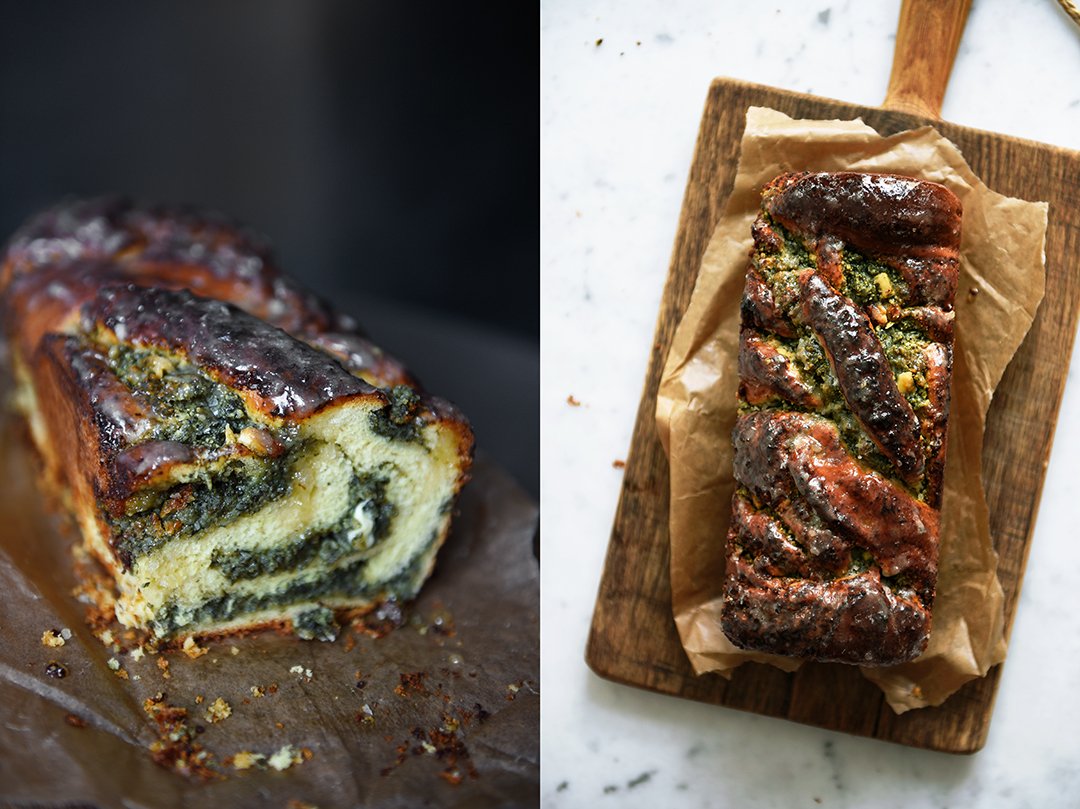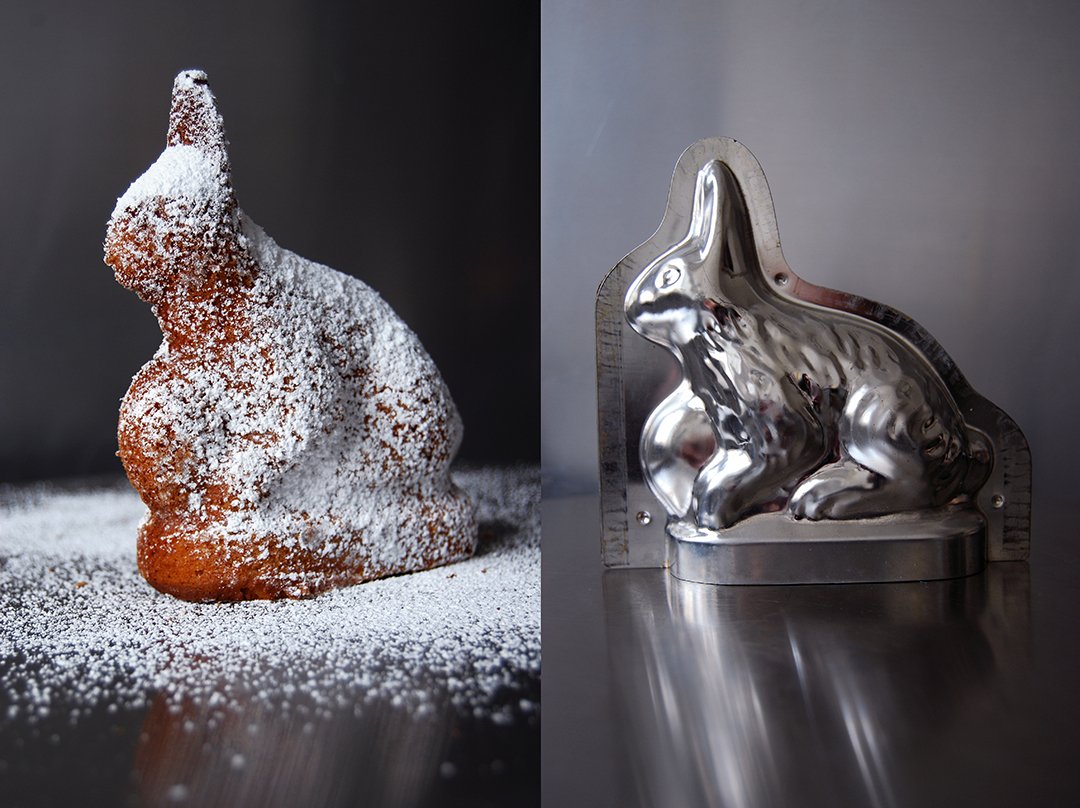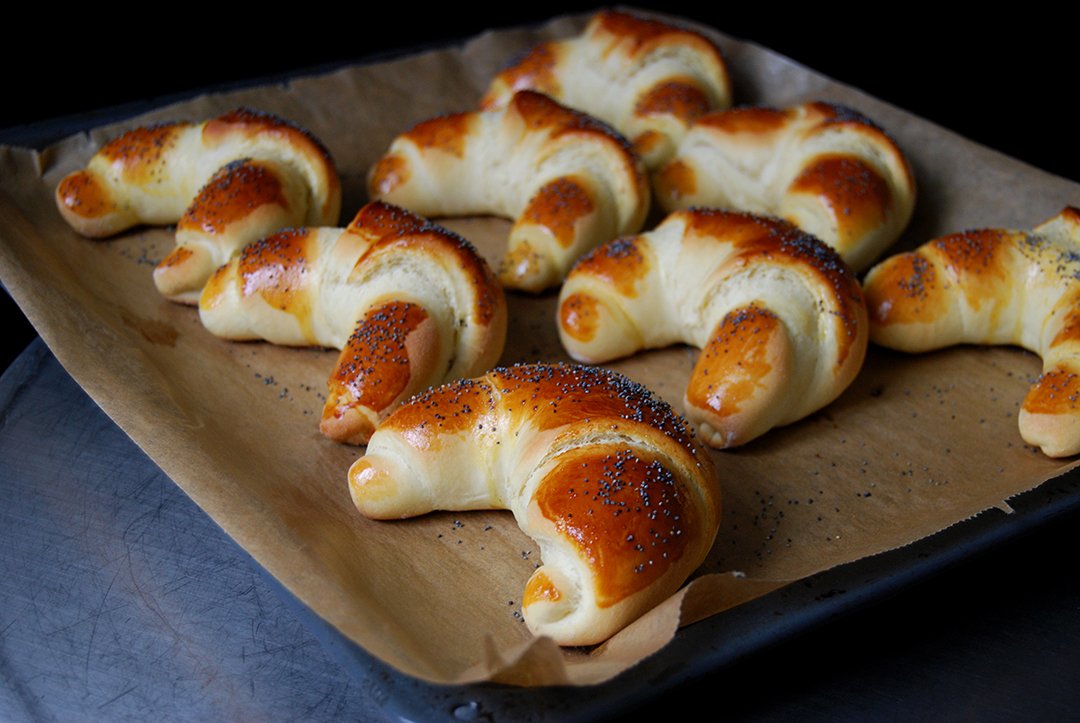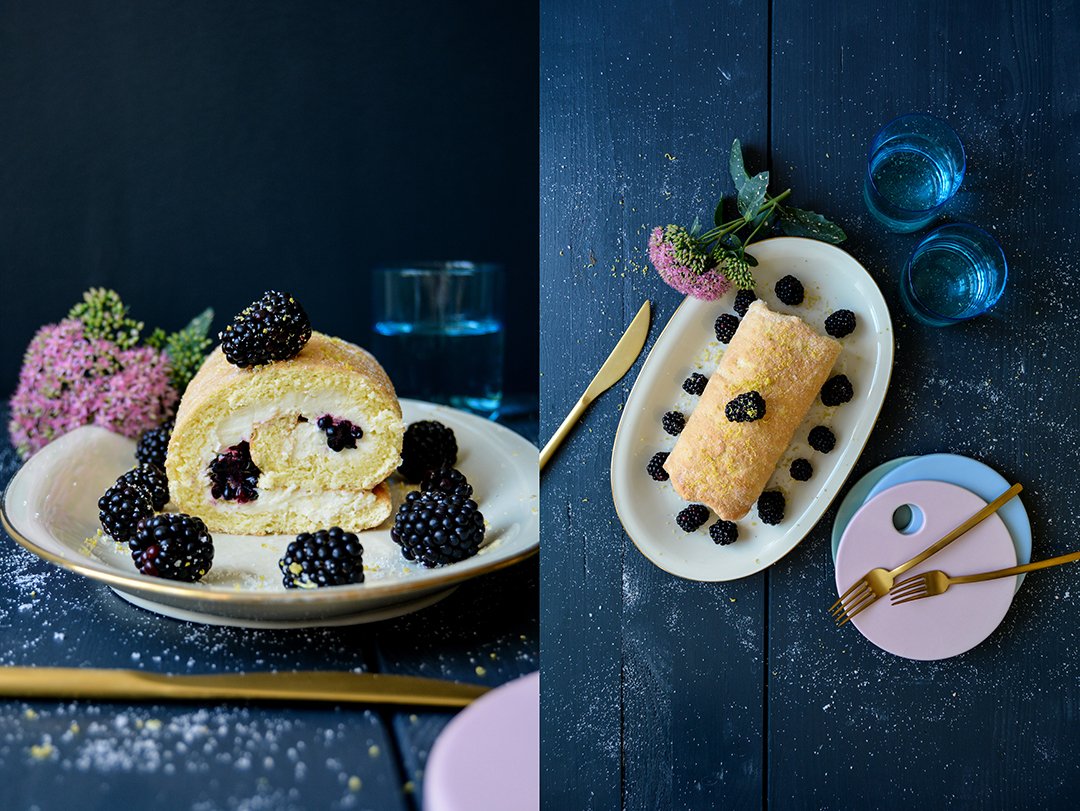Pumpkin Seed and White Chocolate Babka
Sundays are for sugar rushes
I'll be honest, my oven has been off most of the time in the past few months. There was a humble apple pie, a few quiche variations and the obligatory cookies in December to fill the jars - and to fill my apartment with that buttery smell - but apart from that I've been a lazy baker. Yet to compensate for the lean supply of baked goods from my own kitchen - and still satisfy my voracious sweet desires - I dove into a new old passion: regular visits to my trusted Berlin bakers.
My favorite bakeries in the city offer all I would need to never ever have to turn on my oven again (not to say that would ever happen!). Flaky pastries for the mornings, experimental cookie creations from Cookies & Co for my espresso break, and for the afternoons, there's a café/ bakery I've visited for almost 16 years, SowohlAlsAuch Kaffeehaus. They have a decadent hazelnut mascarpone torte, which often crowns my Sunday coffee table. And then there's Café Boulangerie, with their chocolate covered Bundt cake it is a favorite place to go to when I meet my girls for walks in the neighborhood.
Almost any time I'm up for a longer trip across the city just to nibble on Laurel's bagels, Challah knots and rugelach from Fine Bagels, or have my traditional Pfannkuchen (filled doughnuts without a hole, called Berliner where I come from) at New Years and carnival from KaDeWe.
And for sudden cravings, around the corner from my home is a small bakery particularly talented at yeast baked goods like Puddingbrezel (vanilla custard pretzel), tender brioche buns, sticky poppy seed twists and a relatively new discovery: a glorious pumpkin seed twist. I had never before thought of using squash seeds for sweet baking. For pesto, or crunchy salad toppings, yes, but it never occurred to me that it would make sense to mix it, for example, with white chocolate chunks and use that for a babka filling. So I just did that, loved it and here's (finally!) a new recipe on the blog.
It's a wintery variation of my blueberry lemon cheese babka and my poppy seed babka and it fits particularly well to gloomy Sundays in February, when the heart needs some sweetness to fill the gap until spring. And anyway, Sundays are for sugar rushes - doesn't matter if homemade or from your favorite neighborhood bakery.
Pumpkin Seed and White Chocolate Babka
Mind that the babka has to rise twice, the first time overnight (for about 8 hours) in the fridge.
Makes 1 loaf cake.
For the dough
275g / 2 cups plus 2 tablespoons all-purpose flour
50g / 1/4 cup granulated sugar
1 1/2 teaspoons fast-acting yeast
1/4 teaspoon fine sea salt
60ml / 1/4 cup whole milk, lukewarm
1 large egg
1 large egg yolk
75g / 1/3 cup butter, at room temperature, cut into cubes
sunflower oil, to grease the bowl
For the filling
240ml / 1 cup whole milk
50g / 1/4 cup granulated sugar
1 teaspoon cinnamon
150g / 5 ounces pumpkin seeds, finely ground in a food processor
110g / 4 ounces white chocolate, roughly chopped
For the glaze
45ml / 3 tablespoons water
50g / 1/4 cup granulated sugar
Day 1 – in the evening:
For the dough, in the large bowl of a stand mixer fitted with the dough hook attachment, whisk together the flour, sugar, yeast and salt.
In a medium bowl, whisk together the milk, egg and egg yolk and add together with the butter to the flour mixture. Mix with the hook for about 8 minutes then continue kneading and punching the dough with your hands for a few minutes until you have a soft and silky ball of dough. Transfer the dough to a clean, oiled bowl, cover with plastic wrap and leave it in the fridge overnight, or for about 8-10 hours (don't be alarmed, the dough will only rise a little).
Day 2 – in the morning:
Take the dough out of the fridge and let it sit in the bowl at room temperature for about 1-2 hours (this time I even let it sit for 4 hours and the babka rose beautifully).
For the filling, in a medium saucepan, bring the milk, sugar, cinnamon and ground pumpkin seeds to a boil and cook, whisking constantly, over medium-high heat (bubbling) for 5 minutes or until the mixture is spreadable. Let the filling cool completely (I put the pot in the snow on the balcony, whisking occasionally).
Butter an 23 x 10cm / 9 x 4″ loaf pan and line the bottom with a piece of parchment paper.
Punch the dough down, take it out of the bowl and knead for 30 seconds. Roll the dough with a rolling pin into a 40 x 28cm / 16 x 11″ rectangle. Spread the pumpkin seed filling on top, leaving a 2cm / 3/4″ border then sprinkle with the white chocolate. Starting from one long side, roll the dough up into a log (8th picture, below). Use your fingers to squeeze the overlapping dough then flip the roll over so that the seam is at the bottom. Using a sharp knife, cut the roll in half lengthwise (3rd picture, top). The cut sides facing up, place both pieces next to each other then quickly lift one half over the other, repeating to form a twist (4th picture, top). Using the blade of a large knife, gently lift the babka and transfer quickly to the prepared pan. Cover with a tea towel and let it rise in a warm place (I kept the bowl on the heater) for about 60-90 minutes or until puffy.
Preheat the oven to 190°C / 375°F (conventional setting).
For the glaze, in a small saucepan, bring the water and sugar to a boil and cook for 2 minutes or until syrupy then take the pan off the heat and set aside.
Bake the babka for 35-40 minutes or until golden brown and spongy, covering the top of the babka with tin foil after 30 minutes if it gets dark. After 35 minutes, check with a skewer, it should come out almost clean. Take the babka out of the oven and immediately brush the top with the syrup. Let it cool for 10-15 minutes then remove from the pan. Enjoy the babka warm or cold.
16 Recipes for your Easter Brunch Table
Hunting Easter eggs in the woods was one of my childhood's spring highlights. The sweet smell of blossoms and sunlight in the air, the trees' leaves presenting their most fragile green, and - in a lucky year - I could even replace boots and jacket for shirt and jeans while searching for golden wrapped chocolate eggs and bunnies. I always loved the sprouting energy that comes with the change of season, when winter's shades of grey and brown give way to vibrant colours. Easter is a changing point in the year, there's the promise of summer in the air.
Is there a better way to celebrate this day than gathering your loved ones around the table and treating them to a luscious brunch? Here's some inspiration (click the titles for the recipes) - and there will be two new Easter recipes coming up this Sunday and next Wednesday!
Happy Easter!
Tsoureki – Greek Easter Bread with Aniseed and Orange Blossom Water
Poppy Seed and White Chocolate Babka
The past week has been crazy and the best way to put my weary mind at ease, is to dig my hands into a ball of yeast dough and knead, and knead, and knead. You can punch and roll it, letting all your energy out until you're exhausted; or you can knead it gently to calm down and feel the pale ball softening slowly between your fingers. Yeast dough is forgiving, it accepts whatever mood you’re in, and it gets better the longer - and harder - you work with it.
The dough for today's babka had to deal with a lot of energy, I must have looked like a boxer training in my kitchen. And it turned out to be the smoothest, silkiest yeast ball my marble counter tops have ever seen. To make babka, you have to be patient, the dough has to rise overnight in the fridge before it transforms into a braided beauty. But then, if you time it well and start early on the second day, you can enjoy the most fragrant cake on your Sunday breakfast or brunch table. And if you don't feel like hassling and hurrying, just take your time and bake it for teatime.
I already shared a babka recipe here on Eat In My Kitchen, last year's Blueberry Lemon Cheese Babka was a hit, not only on my table. This time I wanted to use poppy seeds for the filling to resemble the famous German Mohnstrudel. It used to be one of my childhood's favourites, preferably generously filled with the dark, black seeds. For my filling, I stirred in a handful of raisins, which is also very common in Germany, they make it a bit fruity. But we're not done yet, I have another addition: chopped white chocolate; divine! It's subtle, you can barely taste the little milky bites, but it makes the filling juicier, fudgy in some parts, which is a great contrast to the fluffy cake. For the shiny finish, I used a sticky sugar glaze and I didn't even wait for it to dry, the first slice of a warm yeast cake is always the best.
Update: Here’s the recipe for my Pumpkin Seed and White Chocolate Babka!
Poppy Seed and White Chocolate Babka
Mind that the babka has to rise twice, the first time overnight (for about 8 hours) in the fridge.
Makes 1 babka
For the dough
plain flour 275g / 2 cups plus 1 tablespoon, plus more if it's too sticky
granulated sugar 50g / 1/4 cup
fast-acting yeast 1 1/2 teaspoons
fine sea salt 1/4 teaspoon
milk, lukewarm, 60ml / 1/4 cup
organic egg 1
organic egg yolk 1
butter, at room temperature, cut into cubes, 75g / 1/3 cup
oil, to grease the bowl
For the filling
milk 210ml / 3/4 cup plus 2 tablespoons
granulated sugar 50g / 1/4 cup
ground cinnamon 1 teaspoon
orange zest 1 teaspoon
poppy seeds, cracked, 125g / 1 1/4 cup
raisins, soaked in warm water for 5 minutes and squeezed gently, 40g / 1/3 cup
white chocolate, chopped, 100g / 4 ounces
For the glaze
water 60ml / 1/4 cup
granulated sugar 100g / 1/2 cup
Day 1 - in the evening:
For the dough, in a large bowl, combine the flour, sugar, yeast, and salt.
Whisk the milk, egg, and egg yolk and add along with the butter to the flour mixture. Knead for about 10 minutes, starting with the dough hooks of a stand mixer and continue kneading and punching with your hands for a few minutes until you have a soft and silky ball of dough. If the dough is too sticky, add a little more flour, but mind that it stays soft. Transfer to a clean, oiled bowl, cover with cling film and put in the fridge overnight.
Day 2 - in the morning:
Take the dough out of the fridge and let at sit at room temperature for about 1-2 hours.
For the filling, in a medium saucepan, bring the milk, sugar, cinnamon, and orange zest to the boil. Take the pan off the heat, stir in the poppy seeds, and let it soak for 5 minutes. Stir in the soaked raisins and let it cool.
Butter an 11 x 24cm / 4 x 9″ loaf pan and line the bottom with a piece of parchment paper.
Punch the dough down, take it out of the bowl, and knead for about 30 seconds. On a floured counter top, roll out the dough with a rolling pin into a 28 x 40cm / 11 x 16″ rectangle. Spread the filling over the dough, leaving a 2cm / 3/4″ rim, and sprinkle with the white chocolate. Starting from one long side, roll up the dough tightly into a log. Pull and press to seal the end onto the roll and place the seam at the bottom. Using a sharp long knife, cut the roll in half lengthwise (see 5th picture). The cut sides facing up, press together two ends and lay one half of the log over the other, continue until you end up with a twisted plait (2nd picture). Push the end together. Tuck the ends underneath the babka and, using the large blade of a knife, lift the loaf and transfer quickly to the prepared pan. Cover with a tea towel and let it rise in a warm place (I keep it on the heater) for about 60-90 minutes or until puffy.
Preheat the oven to 190°C / 375°F (conventional oven). For the glaze, in a small saucepan, bring the water and sugar to the boil and let it cook for 2 minutes, take the pan off the heat and set aside.
Bake the babka in the oven for 30-35 minutes or until golden brown. Check with a skewer, it should come out clean. Mind that depending on where you push it in, there will be melted chocolate on the skewer. Take the pan out of the oven and brush the top immediately with the syrup (use all the syrup). Let the cake cool for about 10-15 minutes before you remove it from the pan. Enjoy slightly warm or cold.
German Poppy Seed Strudel with Cinnamon Crumbles
As a child I went through different sweet phases with quite an obsessive persistence. There were times, if not years, when I bought a scrumptious short crust ring topped with gianduja cream and chocolate at least once or twice a week from my hometown's confectionery, it's a decadent treat called Nougatring in German. When I fell in love with a cinnamony cherry crumble cake from a French bakery as a young teenager I bought a piece of it every day after school. For months I wanted nothing more than this buttery pleasure, it felt like the best culinary discovery of my young life. Luckily, I was always quite tall and didn't have to worry much about the effect of my obsessions on my weight, my culinary enjoyment was always greater than my vanity!
I remember that my family, especially my mother and aunts, used to tell me that I should enjoy it to the fullest as with age, I wouldn't be able to eat these amounts without repentance. They were so right! I simply can't eat so many sweets anymore, a fact which I regret, especially when I have to refuse a piece of tempting cake, this would have never happened in my early years! The only thing that didn't change is my excitement for these treats and my complete misjudgment of the amount of cake that two people can actually eat. I prefer my baked sweets well sized, you never know if an unexpected guest may appear at the door step. The same happened to me a few days ago when I decided to make a traditional German poppy seed cake. This was another one of my childhood favourites, soft and spongy yeast dough wrapped around a juicy poppy seed and raisin filling. In the North Rhine Westphalia area where I grew up, this rich strudel is topped with sweet and buttery crumbles which is simply amazing in combination with the seeds and pastry. When I prepared all the ingredients on the kitchen counter I remembered how much I used to love this cake and decided to make a huge strudel, ignoring the fact that my partner isn't too fond of poppy seeds or yeast cakes for that matter. I didn't expect guests either but I had a rustic picture of a huge strudel in mind, with impressive proportions.
I got what I asked for! The strudel woke up all the culinary memories of my childhood and tasted exactly how I wanted it to be, even my partner liked it a lot, but still, after 2 big slices we just looked at each other and thought "what are we going to do with this massive strudel?". Luckily, I can always rely on my family. My aunt Ursula came for a quick visit, she is as much a fan of this cake as I am. She replaced her dinner with two slices of my strudel monster and she looked very happy when I offered her to take half of it home. The lesson is, a cake can never be too big, there will always be friends and family who enjoy it as much as the baker does!
German Poppy Seed Strudel with Cinnamon Crumbles
For 1 huge strudel for about 10 people you need
For the yeast dough
plain flour 480g / 17 ounces
granulated sugar 80g / 3 ounces
dry yeast 1 sachet (7g / 1/4 ounces)
a pinch of salt
butter, melted, 80g / 3 ounces plus 1 tablespoon to brush the strudel
milk 175ml / 6 ounces
In a large bowl, combine the flour, sugar, yeast and salt. Mix the milk with the melted butter (the mixture should be lukewarm) and add to the dry flour-mixture. Mix with the dough hooks of the mixer for a few minutes, the dough will be quite moist. Dust the kitchen counter with a little flour and continue kneading and punching with your hands for a few minutes until you have a soft and elastic dough ball (if the dough sticks to your fingers add more flour). Put the dough back into the bowl, cover with a tea towel and let it rise in the warm oven (35°C / 95°F) for 70 minutes (top/ bottom heat and not fan-assisted!).
For the poppy seed filling
milk 420ml / 14 ounces
granulated sugar 100g / 3.5 ounces
ground cinnamon 2 leveled teaspoons
orange zest 2 teaspoons
poppy seeds, cracked, 250g / 9 ounces
raisins 80g / 3 ounces
In a sauce pan, bring the milk, sugar, cinnamon and orange zest to the boil. Stir in the poppy seeds and let the mixture cook on lowest heat for about 5 minutes, stirring constantly. When the filling is thick and the milk is soaked, add the raisins, mix and let it cool.
For the crumbles
Prepare the crumbles shortly before baking the strudel.
plain flour 100g / 3.5 ounces (plus more if the crumbles are too sticky)
granulated sugar 60g / 2 ounces
ground cinnamon 1 teaspoon
butter, melted, 60g / 2 ounces (plus more if the crumbles are too fine)
Combine the dry ingredients in a bowl, add the melted butter and mix quickly with the hooks of your mixer, stop as soon as the mixtures crumbles. If it doesn't form crumbles, add a little more flour and sugar, if the crumbles are too fine add a bit more melted butter.
The strudel
Set the oven to 180°C / 355°F (top/ bottom heat).
Take the dough out of the bowl, punch it down and knead for 1 minute.
Dust a piece of parchment paper (big enough to cover a baking sheet) with a little flour. Roll out the dough on the parchment paper until it's roughly 35 x 35cm / 14 x 14". Spread the poppy seed filling on it evenly, leave a rim of 1-2cm / 1/2-1". Roll the dough up tightly, gently pull off the parchment paper while rolling the dough. The fold should be at the bottom. Close the sides well, cover with a tea towel and let it rise for 15 minutes (on a baking sheet lined with parchment paper).
Brush the strudel with 1 tablespoon of melted butter. Prepare the crumbles, spread them over the strudel and gently push them into the yeast dough. Bake for 50 minutes or until the yeast dough is golden brown.

















































